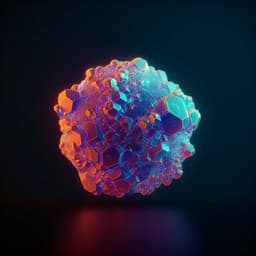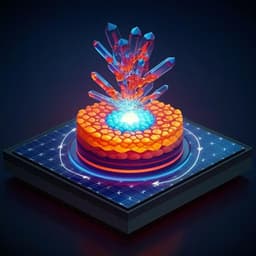
Physics
Carrier multiplication in perovskite solar cells with internal quantum efficiency exceeding 100%
Y. Wang, S. Ye, et al.
This cutting-edge research conducted by Yue Wang and his colleagues investigates carrier multiplication (CM) in Cs0.05FA0.5MA0.45Pb0.5Sn0.5I3 perovskite solar cells. The study reveals remarkable CM effects that can significantly enhance the efficiency of photovoltaic cells, surpassing conventional limits with an unbiased internal quantum efficiency exceeding 110%. A redesign of the device architecture is proposed to fully harness this potential, paving the way for next-generation solar technologies.
~3 min • Beginner • English
Introduction
Solar energy conversion faces the Shockley–Queisser efficiency limit for single-junction solar cells (~33%), largely due to thermalization losses where excess photon energy above the bandgap is dissipated as heat. Metal halide perovskite solar cells (PSCs) have rapidly advanced in power conversion efficiency but are still bound by this limit. Carrier multiplication (CM), also known as multiple exciton generation (MEG), can convert a single high-energy photon into multiple electron–hole pairs, offering a pathway to exceed the SQ limit with a theoretical maximum efficiency of ~44.4%. Prior spectroscopic studies have suggested favorable conditions for CM in halide perovskites due to slow hot-carrier cooling. However, direct evidence in operational PSC devices under zero-bias solar cell conditions has been lacking, partly because common Pb-based perovskites have CM thresholds at photon energies with low solar irradiance and device stacks suffer from parasitic absorptions. The research question addressed here is whether CM can be realized and directly evidenced in working perovskite solar cells, and whether it can increase internal quantum efficiency (IQE) beyond 100% under zero-bias conditions. The study focuses on mixed Pb–Sn perovskites with narrower bandgaps, aligning the CM threshold near the peak of the solar spectrum, and examines how device architecture and optical/electronic losses influence the observable CM contributions.
Literature Review
Previous reports demonstrated low CM/MEG thresholds and high quantum yields in halide perovskite nanocrystals such as FAPbI3 and CsPbI3, and evidence for efficient CM in low bandgap mixed Sn/Pb perovskites in film form. These insights arise primarily from transient absorption spectroscopy on bare films or nanocrystals rather than complete devices. While MEG-enhanced photodetector responses under UV/deep-UV excitation have been shown for perovskite nanocrystals, analogous demonstrations in zero-bias solar cells are scarce. Conventional Pb-based perovskites (bandgaps ~1.7 eV) require CM thresholds ≥3.4 eV (≤365 nm), where solar irradiance is weaker and device substrates/electrodes (glass, ITO/FTO) introduce significant parasitic absorptions below ~400 nm, limiting any CM impact. Mixed Pb–Sn perovskites with narrower bandgaps (~1.17–1.30 eV) shift the CM threshold to ~2Eg (~500 nm), coinciding with strong solar spectral intensity, making them promising candidates. Nevertheless, comprehensive device-level validation of CM, and understanding of competing optical/electronic loss channels that can mask CM in PSCs, have been lacking.
Methodology
Materials and absorbers: Mixed Pb–Sn perovskite Cs0.05FA0.5MA0.45Pb0.5Sn0.5I3 (Eg ~1.24 eV) precursor solutions were prepared by combining MAI, FAI, CsI, PbI2, SnI2, SnF2, GuaSCN, and Sn powder in DMF:DMSO (4:1). A related narrow bandgap composition (FASnI3)0.6(MAPbI3)0.4 was also prepared. Film thickness was controlled by precursor concentration (1.2–2.0 M for device films; ~30 nm for characterization), spin-coating, anti-solvent quenching with toluene, and annealing. Vacuum-assisted crystallization (−1 bar for 8 min) was employed for certain films to obtain thicknesses of ~250–560 nm. MAPbI3 reference films (~340 nm) were prepared from 1.55 M precursors in DMF:DMSO (9:1) with anti-solvent toluene and annealing.
Device architectures: Inverted PSCs were fabricated primarily on quartz/ITO substrates with a self-assembled monolayer HTL (2PACz), yielding the stack Quartz/ITO/2PACz/Perovskite/C60/BCP/Ag. Glass/ITO with PEDOT:PSS HTL devices were also prepared for comparison. Substrates were sequentially cleaned and O2 plasma treated. 2PACz (0.5 mg mL−1 in ethanol) was spin-coated, annealed, rinsed, and re-annealed. Perovskite layers were spin-coated, vacuum-pumped, annealed, and post-treated with an ethylenediamine (EDA) solution (0.1 mM in toluene), followed by thermal evaporation of C60 (50 nm), BCP (6 nm), and Ag (100 nm). A 100 nm LiF anti-reflection layer was deposited on the substrate side for 1 Sun PCE and EQE measurements. PEDOT:PSS-based devices used glass/ITO/PEDOT:PSS as HTL prior to perovskite deposition and the same ETL/cathode stack.
Spectroscopy and CM assessment in films: Transient absorption (TA) spectroscopy was performed using femtosecond pump-probe setups (800 nm, 1 kHz, 50 fs regenerative amplifier; SHG at 400 nm; OPA output; NIR white-light probe 800–1400 nm). Mixed Pb–Sn films were pumped across photon energies 1.54–4.96 eV to evaluate initial photobleach amplitudes near 1.33 eV and determine the absorbed photon flux required to reach the same early-time bleach (1–3 ps). The onset and efficiency of CM were inferred from reductions in required absorbed photon flux above threshold energies and from gradients proportional to CM quantum yield.
Device electrical/optical characterization: J–V under one sun (AM 1.5 G, 100 mW cm−2) was measured using a class AAA simulator, calibrated with a certified reference cell, in N2 glovebox. Device areas were 0.06 cm2 for J–V and variable smaller illuminated areas under monochromatic CW lasers for CM studies; beam diameters were characterized by CMOS camera and Gaussian profile assumption. J–V scans were performed in reverse from 1.0 V to −0.2 V at −0.5 V s−1. EQE spectra were measured with a dedicated system. Absorption, reflection (with integrating sphere), and material optical constants (n, k via ellipsometry and Kramers–Kronig-consistent b-spline modeling) were obtained for optical analyses. UPS characterized energy levels. AFM provided film morphology.
Monochromatic illumination CM in devices: Short-circuit current density Jsc was measured as a function of absorbed photon flux IA under 473 nm (2.62 eV), 532 nm (2.33 eV), and 655 nm (1.89 eV) excitation to derive IQE = (Jsc/e)/IA normalized by perovskite absorptance and device reflectance/transmittance. MAPbI3 reference devices served as controls, given their higher CM threshold (≥3.1 eV). The slope of Jsc versus IA above threshold indicates CM contributions.
Broadband illumination CM and optical modeling: For quartz/ITO/2PACz-based devices with varied perovskite thickness (250–560 nm), EQE and derived IQE (accounting for reflectance and ITO/2PACz transmittance) were evaluated under AM 1.5 G. Optical modeling incorporating measured n, k and stack geometry validated IQE > 100% near ~2Eg. Independent cross-checks were performed at the Solar Energy Research Institute of Singapore (SERIS).
Key Findings
- Film-level CM: Transient absorption spectroscopy on Cs0.05FA0.5MA0.45Pb0.5Sn0.5I3 (Eg ~1.24 eV) shows a CM onset at ~2Eg (2.48 eV, ~500 nm). The CM efficiency is 99.4 ± 0.4%, with reduced absorbed photon flux needed to reach identical early-time bleach amplitudes above threshold. Among Pb–Sn ratios studied, Pb0.5Sn0.5 exhibited the most efficient CM, likely due to slowest hot-carrier cooling.
- Device-level CM under monochromatic light: Mixed Pb–Sn PSCs exhibited increased Jsc slope versus absorbed photon flux at 473 nm (2.62 eV, 2.11Eg) relative to below-threshold excitations (532 and 655 nm). Derived IQE exceeded 100% under 473 nm excitation. MAPbI3 control devices (bandgap 1.55 eV) showed constant slopes and no IQE enhancement at the tested wavelengths, consistent with their higher CM threshold (≥3.1 eV).
- Broadband solar illumination with optimized stacks: Using Quartz/ITO/2PACz/Perovskite/C60/BCP/Ag, champion devices showed clear CM signatures with IQE > 100% near the 2Eg threshold. Peak IQE reached ~161.5% at hv = 3.33Eg for the thin perovskite device (1.2 M, ~250 nm), and ~142.5% for the thick device (2.0 M, ~560 nm) with thresholds ~2Eg and ~2.08Eg, respectively. Average peak IQE for champion quartz-based devices was ~157 ± 4%.
- Photovoltaic performance: The thickest device (2.0 M; ~560 nm) achieved PCE 19.19% (Voc 0.85 V, Jsc 30.55 mA cm−2, FF 0.74). Other thicknesses yielded PCEs from 16.06% to 18.85% with corresponding Voc, Jsc, FF as tabulated. Integrated Jsc from EQE agreed within −6%.
- Optical/electronic loss analysis: Parasitic absorption from glass/ITO and interlayers, thickness-dependent recombination (notably in thick films, potentially from Sn2+ oxidation), and interfacial energy alignment impede CM contributions to EQE and PCE. Replacement of PEDOT:PSS and glass by 2PACz and quartz reduces losses, revealing CM-driven IQE enhancement.
- Cross-validation: Optical modeling of the device stack supports IQE > 100% near the CM threshold, and independent measurements at SERIS corroborate the IQE findings.
- Benchmarking: Compared to PbSe and PbS devices (CM thresholds ~3Eg and ~2.5 ± 0.3Eg, respectively), the mixed Pb–Sn PSCs show a lower threshold (~2Eg) with IQE ~160% at hv = 3.33Eg, indicating competitive or superior CM performance at lower photon-energy multiples.
Discussion
The study directly addresses whether carrier multiplication can be realized in operational perovskite solar cells and whether it can enhance charge generation beyond unity per absorbed photon. Demonstrating IQE exceeding 100% without external bias confirms CM in mixed Pb–Sn PSCs and bridges the gap between spectroscopic indications in films and functional device performance. The findings further reveal that standard PSC architectures obscure CM contributions due to parasitic absorption (glass, ITO, intervening layers), recombination losses (defects, potentially exacerbated by Sn2+ oxidation), and trade-offs in absorber thickness that differentially impact short- and long-wavelength collection. By engineering the device stack with quartz substrates and 2PACz SAMs, the work mitigates these losses, enabling clear observation of CM-induced IQE gains and clarifying the interplay among optical absorptance, carrier transport, and recombination. These results suggest that CM effects likely exist in current mixed Pb–Sn PSCs but are masked by architecture-dependent losses. The significance lies in identifying concrete design pathways—transparent conducting layers with higher UV transmittance, optimized interfaces and transport layers, and thickness engineering—to harness CM for tangible efficiency improvements and to inform tandem architectures that capitalize on CM at short wavelengths while maintaining strong long-wavelength harvesting.
Conclusion
This work provides clear device-level evidence of carrier multiplication in mixed Pb–Sn perovskite solar cells. In Cs0.05FA0.5MA0.45Pb0.5Sn0.5I3, a low CM threshold (~2Eg) and high CM efficiency (99.4 ± 0.4%) are verified by ultrafast spectroscopy. Optimized quartz/ITO/2PACz device architectures achieve unbiased IQE well above 100%, peaking near ~160% under broadband illumination, with a champion PCE of 19.19% for thicker absorbers. The study elucidates how absorber thickness, parasitic absorption, defect-mediated recombination, and interfacial energy alignment govern the observable CM contributions in PSCs. Future research should focus on redesigning device stacks to minimize parasitic and recombination losses (e.g., alternative high-UV-transmittance transparent conductors like graphene, improved ETLs/HTLs, interface passivation), engineering perovskite absorbers for enhanced long-wavelength optical thickness, and integrating CM-active mixed Pb–Sn cells in tandem configurations with Si or wide-bandgap perovskites to surpass the SQ limit.
Limitations
Observed CM benefits are constrained by device architecture: (1) parasitic absorption in glass/ITO and intervening layers reduces high-energy photon absorption by the perovskite; (2) a trade-off between thin absorbers that favor short-wavelength CM collection and thick layers needed for long-wavelength harvesting; (3) increased recombination in thicker mixed Pb–Sn films, potentially linked to defects and Sn2+ oxidation; and (4) suboptimal interfacial energy alignment and carrier extraction at the perovskite/HTL interface. These factors can mask or diminish CM contributions to EQE and overall PCE. The results depend on careful optical corrections (reflectance and transmittance) and accurate determination of absorbed photon flux, which can introduce uncertainties if not properly accounted for.
Related Publications
Explore these studies to deepen your understanding of the subject.







